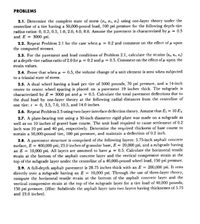
Concept explainers

Trending nowThis is a popular solution!
Step by stepSolved in 2 steps

Determine the complete state of stress (δz , δr , δt ) using one layer theory under the
centerline of a tire having 50000 Ib load, 100psi pressure for the following depth-tire
radius ratios: 0, 0.5, 2. Assume the pavement is characterized by μ = 0.5 and E =
3000psi.
A dual wheel having a load per tire of 5000 Ib, 70 psi pressure and μ = 0.5. Calculate the
total pavement deflections due to the dual wheel by one-layer theory at the following
radial distances from the centerline of one tire: r=0, 3.5,10.5. (Use Pavement Thickness
= 8in).
A dual wheel having a load per tire of 4000 Ib, 80 psi pressure and μ = 0.5. Calculate the
total pavement deflections due to the dual wheel by two layer theory at the following
radial distances from the centerline of one tire: r=0, 7,14. Assume that E1 = 10 E2
Determine the complete state of stress (δz , δr , δt ) using one layer theory under the
centerline of a tire having 50000 Ib load, 100psi pressure for the following depth-tire
radius ratios: 0, 0.5, 2. Assume the pavement is characterized by μ = 0.5 and E =
3000psi.
A dual wheel having a load per tire of 5000 Ib, 70 psi pressure and μ = 0.5. Calculate the
total pavement deflections due to the dual wheel by one-layer theory at the following
radial distances from the centerline of one tire: r=0, 3.5,10.5. (Use Pavement Thickness
= 8in).
A dual wheel having a load per tire of 4000 Ib, 80 psi pressure and μ = 0.5. Calculate the
total pavement deflections due to the dual wheel by two layer theory at the following
radial distances from the centerline of one tire: r=0, 7,14. Assume that E1 = 10 E2
- Circly was used to analyse a pavement structure. The horizontal tensile strain at the bottom of a subbase made of lean mix (lean rolled ) concrete was 106 microstrain. Assume RF = 1 Estimate the allowable number of standard load repetition.arrow_forwardThe overall standard deviation in the flexible pavement design equation accounts for the variation in the loading, materials and the construction practices. O True O Falsearrow_forward• Question 26 The maximum wheel load that the pavement could carry is 120 kN. If the contact radius of the wheel is assumed to be 250 mm, and subgrade bearing capacity is equivalent to 0.24 Megapascals, calculate the subgrade layer thickness of the flexible pavement in mm using the 45-deg cone pressure distribution method.arrow_forward

 Structural Analysis (10th Edition)Civil EngineeringISBN:9780134610672Author:Russell C. HibbelerPublisher:PEARSON
Structural Analysis (10th Edition)Civil EngineeringISBN:9780134610672Author:Russell C. HibbelerPublisher:PEARSON Principles of Foundation Engineering (MindTap Cou...Civil EngineeringISBN:9781337705028Author:Braja M. Das, Nagaratnam SivakuganPublisher:Cengage Learning
Principles of Foundation Engineering (MindTap Cou...Civil EngineeringISBN:9781337705028Author:Braja M. Das, Nagaratnam SivakuganPublisher:Cengage Learning Fundamentals of Structural AnalysisCivil EngineeringISBN:9780073398006Author:Kenneth M. Leet Emeritus, Chia-Ming Uang, Joel LanningPublisher:McGraw-Hill Education
Fundamentals of Structural AnalysisCivil EngineeringISBN:9780073398006Author:Kenneth M. Leet Emeritus, Chia-Ming Uang, Joel LanningPublisher:McGraw-Hill Education
 Traffic and Highway EngineeringCivil EngineeringISBN:9781305156241Author:Garber, Nicholas J.Publisher:Cengage Learning
Traffic and Highway EngineeringCivil EngineeringISBN:9781305156241Author:Garber, Nicholas J.Publisher:Cengage Learning





